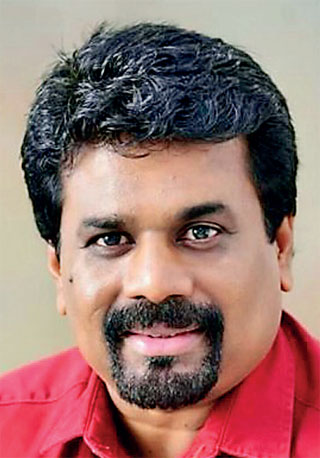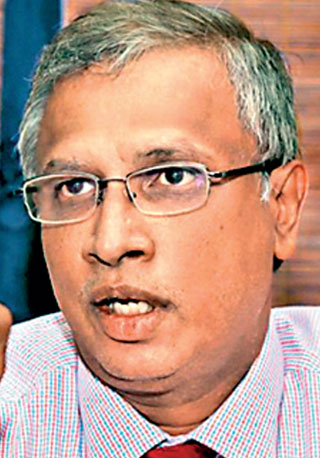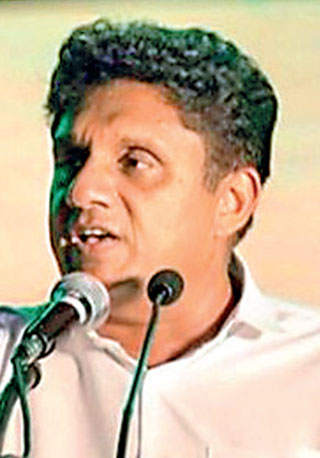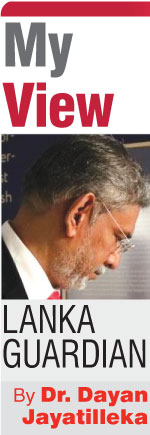Friday Apr 18, 2025
Friday Apr 18, 2025
Thursday, 13 January 2022 00:20 - - {{hitsCtrl.values.hits}}

Anura Kumara Dissanayake

M.A. Sumanthiran

Sajith Premadasa
|
 Bullock-drawn kerosene carts are back in Colombo, a scene I last saw 60 years ago. Ubiquitous queues we saw 45 years ago. Patchy, yellowed fields we never saw. Symbols of a Great Leap Backward.
Bullock-drawn kerosene carts are back in Colombo, a scene I last saw 60 years ago. Ubiquitous queues we saw 45 years ago. Patchy, yellowed fields we never saw. Symbols of a Great Leap Backward.
President GR recently visited Ruvanwelisaya in the company of Army chief General Shavendra Silva. Dutugemunu began his victorious long march only after ascertaining that his kingdom’s granaries were full of rice. With this President’s policies, the harvest won’t produce full granaries.
Here’s his silver bullet: “The Army has been sent in to implement government policy on organic farming by monitoring and educating farmers on the job they have to do.” (ST, 9 Jan. 2022)
Low Marx
JVP-NPP leader Anura Kumara Dissanayake’s deficiency as a serious Left leader in a time of complex crisis is evident in his answer to a crucial question about the dangers of a repressive militarist response, outcome or interlude:
“…Not only the Rajapaksas, but no one else could lead this country to such suppressive rule…There is no room for a military regime in Sri Lanka…there is no possibility of that.” (DM 5 Jan. 2022)
UN Human Rights High Commissioner Michelle Bachelet, a Chilean Socialist leader, ex-President, ex-Defence Minister and former fighter against Pinochet’s dictatorship, whose father, an Air Force General died under torture by the military junta, has consistently spotlighted the accelerated growth of militarisation in Sri Lanka. How long till metastasis and how to prevent it?
For AKD to flatly proclaim there is “no room…no possibility” of such an outcome, is to demobilise rather than alert the public. That, together with his spurning of a political united front of democratic or even Left (JVP+FSP) forces, encourages rather than deters military-dominated rule.
Tamil testament
The Tamil parties of the north and east finally signed a text that represents a consensus. Let’s begin with the downside. ‘Bloat’ turned a parsimonious one-page draft agreed upon by convening parties and the SLMC, into a seven-page dossier, embedding at the ITAK’s insistence every promise reneged on by every Sri Lankan government since 1987.
The historical truth is that while those offers were on the table throughout the war, the ITAK/TULF never took them up. When CBK’s August 2000 draft Constitution made it to parliament, Sampanthan broke his promise to Lakshman Kadirgamar and declined to vote for it. In 2011 when war-winning President Mahinda Rajapaksa sat down to negotiate with the TNA which had backed the losing side in a long civil war, the TNA refused to take the 13th amendment as the framework or baseline for negotiations.
The consolidated Tamil text has a commitment to federalism and to “self-determination” within a united country. Most federal systems make no reference to self-determination, with India, the USA and Australia being examples. Ethiopia did, and look how that’s gone. India will be wary because ‘self-determination’ is a keyword for the Kashmiri cause and Pakistan’s discourse.
Such loaded terms in an appeal for the full implementation of the 13th amendment play into the hands of Sinhala hardliners who allege that 13A is a transit-lounge for federalism and self-determination.
The recent interview given to an English-language Sunday paper by the ITAK’s M.A. Sumanthiran helps the regime’s hawks:
“…we are seeking meaningful sharing of powers of governance; and that it can only happen within a federal framework. Whatever you want to call it, it must have the features of a federal constitution…it is not the mandate the TNA received from our people, nor is it the legitimate political aspiration of our people to have 13A implemented…” (SM, 9 Jan 2022)
When 13A is itself in danger, Sumanthiran’s federalist fundamentalism raises questions whether the goal is an achievable, tangible politico-institutional space for the Tamil people/areas, or a mirage that can endure and ensure a political lifetime.
Surreally, Sumanthiran is betting on the USA acting through the agency of the UNHRC to facilitate federalism in Sri Lanka claiming that in recent discussions in DC he was given favourable signals.
Foreign Minister Wang Yi doubtless diligently noted Sumanthiran’s ultimatum that the Chinese should get out of Dodge: “We have clearly stated that the Chinese are not welcome in the North or the East. I have given reasons for that.” (ibid)
Sumanthiran’s bombastic exegetical bluster apart, what makes the joint letter, a TELO initiative, a historically significant achievement are three facets. Firstly, the addressee: India’s Prime Minister Narendra Modi. Secondly, the signatories, the broadest ingathering for decades, covering almost the full spectrum of Tamil politics in the north and east. Thirdly, the operative part of the letter, an appeal to the Indian PM:
“In this situation, we appeal to Your Excellency to urge the Government of Sri Lanka to keep its promises to:
(i)fully implement the provisions of the Thirteenth Amendment to the Constitution
(ii)implement the clear commitments made by all sections of government from 1987 onwards…”
|
Rajapaksanomics and Ranilnomics
The Trincomalee oil tank farm deal confirms that contemporary (post-MR) Rajapaksanomics – Gotanomics, Basilnomics or Pohottunomics – and Ranilnomics are on a continuum.
The Trinco deal mirrors on a more modest scale, the Hambantota deal of Prime Minister Wickremesinghe. The Chinese got a chunk in Hambantota; the Indians a smaller chunk in Trinco. Having started by arrogantly pulling the plug on the Port City and all Chinese projects, Ranil gave the Chinese a bigger footprint in Hambantota than they had been given by President Mahinda Rajapaksa.
The ruling SLPP, which contains many who participated in the JVP-inspired protests against the Indo-Sri Lanka accord, has given India far more than was contained in the Accord as pertains to Trincomalee. Ranilnomics opened the portal.
“… According to Article 2 (iii) of the letter exchanged between the Prime Minister of India and Sri Lanka President on 29 July 1987, the Trincomalee Oil Tank Group agreed to operate as a joint venture between India and Sri Lanka.
Under an agreement signed on 7 February 2003, all 99 tanks at the Trincomalee Tank Complex were handed over to the LIOC on a 35-year lease basis…
In 2017, the Government agreed to lease all 99 tanks to India on a 99-year lease basis under the Malik-Sushma Memorandum of Understanding (MoU)…” (Daily FT)
Who in 2003 and 2017 drove these giveaways; this shift from the more favourable “joint venture” of 1987? Prime Minister Ranil Wickremesinghe. Who gave the Chinese a bigger chunk of Hambantota than did President Mahinda Rajapaksa, thereby motivating and activating India’s push for approximate symmetry in the form of a Trincomalee re-set? Again, Ranil Wickremesinghe.
The excuse that Wickremesinghe was hoping to deter the LTTE by leasing the tanks to India in 2003 is lamentably lame. The report of the United States Pacific Command (PACOM) had highlighted how vulnerable Trincomalee, including the harbour, had become to LTTE artillery emplacements under the Ceasefire Agreement (CFA). Milinda Moragoda had arranged for the PACOM team’s visit. Ranil buried the PACOM report. Iqbal Athas of the Sunday Times scooped it. President Kumaratunga and Lakshman Kadirgamar flew to Delhi with the PACOM report and briefed Prime Minister Manmohan Singh of the danger to Sri Lanka and India.
Gotabaya Rajapaksa as Secretary/Defence fed the recommendations of the PACOM report into the war-winning Sri Lankan strategy.
Wickremesinghe’s supposedly sagacious leasing of the oil tanks to Trincomalee to deter the LTTE in 2003, doesn’t explain the content and intent of the 2017 MoU. In terms of foreignisation, today’s Rajapaksanomics is next-level Ranilnomics.
|
NPPnomics
The JVP-NPP’s critique of Pohottunomics is limited to two dimensions: Corruption and foreignisation. But there is a third dimension which is both empirical and doctrinal/paradigmatic: the rejection of an Open Economy, and the identification the introduction of the Open Economy in 1977 as the ‘Great Fall’. Here, the GR-SLPP Establishment and the JVP-NPP alternative share common ground.
The JVP-NPP has yet to criticise the state-capitalist closed economy model of 1970-1977 that led to destitution and malnutrition to the point of semi-starvation. It does not critically note any homology between today’s Gotanomics or a core aspect of it, and the Sirimavo-NM model of 1970-’77.
Today the citizenry is suffering unprecedentedly, not from the Open Economy but its opposite; its closure and wrecking.
NPPnomics is ‘red Gotanomics’. The opening up of the economy in 1977 represented progressive modernisation in relation to the preceding economy of closure, scarcity and backwardness. As it became entrenched though, the 1977 Open Economy was reactionary in relation to what it should and could be. That latter potential was realised and a better, different, much more equitable model operationalised for the few short years he was in office, by President Ranasinghe Premadasa.
What must be rejected is neoliberal globalism/free-market fundamentalism, not globalisation as such, still less an open economy. Sri Lanka needs an East Asian model open economy with a strategic role for the state, as the mainframe supporting a Western-style social democracy—underpinning and guaranteeing social sustainability and the stability of the open economy itself.
While SL-born Prof. Howard Nicholas remains our most intellectually formidable scholar on political economy and comparative international development, Dr. Nishan de Mel, our most compellingly lucid mind on economic policy, has illumined the minefield of the debt crisis and led social opinion against the 18 January payout.
|
Opposition’s options and openings
There is hostility in some ex-UNP and civil society circles towards my long-standing insistence that the defence of liberal democracy requires a strategic shift involving the incorporation of populism, so as to win over the bulk of Pohottuwa voters.
Now, the latest issue of Foreign Affairs, the flagship of scholarly journals on international relations and foreign policy (which first published, in 1947, George Kennan’s famous foundational essay on the doctrine of Containment) features a piece with the strap ‘Why Protecting Liberalism Will Require a Dose of Populism’ entitled ‘January 6th and the Paradoxes of America’s Democracy Agenda’.
It is authored by Larry Diamond, Senior Fellow at the Hoover Institution and Senior Fellow in Global Democracy at Stanford University’s Institute for International Studies. Grappling with how to defeat autocrats, Diamond nails it, using real-world examples:
(https://www.foreignaffairs.com/articles/united-states/2022-01-06/january-6-and-paradoxes-americas-democracy-agenda)
Diamond calls for a liberal-centrist-populism/populist, as exemplified by the most successful US Democrat trio, Roosevelt-Clinton-Obama.
AKD and the JVP-NPP are no liberal-centrists, still less do they fit the US Democrat template. Nor do they declare themselves social democrats.
Sajith story at 55
Son of a martyred populist President, Mill Hill School and LSE-educated Sajith Premadasa who interned with Senator Larry Pressler (R), former chair of the powerful US Senate Foreign Relations Committee, already fits Larry Diamond’s bill.
When his father was blown up on the city’s streets while leading a May 1st demonstration in 1993 by a suicide-bomber, Sajith didn’t stay on in the USA until the trauma abated. He came back and plunged into politics in 1994, not in Colombo which his father represented, but in the Deep South, Hambantota.
A few years before, Sajith had been billed to speak on a party platform in the Western Province. His father lost his cool, berated the local organiser and admonitorily advised his son: “If you want to enter politics, first do your academic studies and then come in through a place like Hambantota, even contesting a Pradesheeya Sabha.” Not many knew of his late father’s emphatic counsel; I heard it from President Premadasa.
Sajith honoured his assassinated father’s wishes and took the road less travelled.
In Hambantota, Sajith fought Mahinda Rajapaksa, beating him in early encounters. After Ranil Wickremesinghe signed the Ceasefire Agreement (CFA) with Prabhakaran, the UNP was finished in the Deep South – the historical Ruhuna – but Sajith stayed on for 20 years waging “battles won or lost – but fought – against the enemy” (Che Guevara) gaining more political battlefield experience against the Rajapaksa oligarchy in the Sinhala heartland than any other political leader.
In November 2019 when Gotabaya Rajapaksa was at the unassailable zenith of his popularity, Anura Kumara didn’t dare enter the ring. Sajith Premadasa did, without the leadership of his party, only after Gotabaya had done several laps as Pohottuwa candidate in the company of Mahinda Rajapaksa. The gap between GR and Sajith was only 10%. Sajith missed the magic 50% mark by 8%. Today, how many voters regret not opting for Sajith in November 2019 and voting for GR instead?
Now he has returned to the city where his father rose, ruled and died.
In the Netflix series Jennifer Jones, the protagonist’s mother rebuts her self-deprecatory disclaimer that she is no hero: “A hero is someone who gives a f**k and does something about it”. Sajith’s donor-driven gifts of high-tech equipment to under-equipped hospitals and for smart classrooms in underprivileged areas, while he is Opposition Leader, not a Minister, and which funds he could have used for party activities, shows me he measures up.
Sajith Premadasa, together with his wife Jalani, took off to the island’s north and east (including Kilinochchi-Mullaitivu) – from where the suicide-bomber who assassinated his father came—on a packed program a week before his birthday. He donated medical equipment in his father’s memory to the hospital in Velvettiturai, the hometown of Prabhakaran, who sent the suicide-bomber. Sajith Premadasa turned 55 in Jaffna with no election in sight.
Discover Kapruka, the leading online shopping platform in Sri Lanka, where you can conveniently send Gifts and Flowers to your loved ones for any event including Valentine ’s Day. Explore a wide range of popular Shopping Categories on Kapruka, including Toys, Groceries, Electronics, Birthday Cakes, Fruits, Chocolates, Flower Bouquets, Clothing, Watches, Lingerie, Gift Sets and Jewellery. Also if you’re interested in selling with Kapruka, Partner Central by Kapruka is the best solution to start with. Moreover, through Kapruka Global Shop, you can also enjoy the convenience of purchasing products from renowned platforms like Amazon and eBay and have them delivered to Sri Lanka.
Discover Kapruka, the leading online shopping platform in Sri Lanka, where you can conveniently send Gifts and Flowers to your loved ones for any event including Valentine ’s Day. Explore a wide range of popular Shopping Categories on Kapruka, including Toys, Groceries, Electronics, Birthday Cakes, Fruits, Chocolates, Flower Bouquets, Clothing, Watches, Lingerie, Gift Sets and Jewellery. Also if you’re interested in selling with Kapruka, Partner Central by Kapruka is the best solution to start with. Moreover, through Kapruka Global Shop, you can also enjoy the convenience of purchasing products from renowned platforms like Amazon and eBay and have them delivered to Sri Lanka.